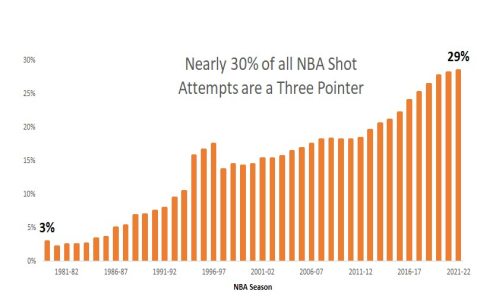The three-point shot has transformed the NBA from a league dominated by interior play into a perimeter-oriented spectacle. Introduced in the 1979-80 season, the arc was initially viewed as a gimmick; teams attempted fewer than three triples per game and made them at a 28 % clip. Fast-forward to 2023-24, and clubs launch an average of 34 threes a night, hitting 36 %. The strategic shift is quantified by one number: 0.27 additional expected points per possession when a three replaces a long two. Coaches once preached “get to the rim”; today they mandate “get to 35 feet and fire if open.”
Stephen Curry is the revolution’s avatar. Between 2015 and 2019 he drilled 1,595 threes, forcing defenses to extend 30 feet from the basket and creating 4-on-3 driving lanes teammates exploited en route to three titles. Tracking data show that Golden State’s offense generated 1.12 points per possession when Curry ran off a screen 25 feet out—higher than a Shaquille O’Neal post-up in 2000. The ripple effect is league-wide: big men such as Karl-Anthony Towns and Brook Lopez now shoot 38 % on four attempts per game, stretching the floor and rendering traditional rim-protectors obsolete.
Analytics departments quantify every inch. Teams discovered that corner threes are worth 1.18 points per shot—identical to a 59 % layup—because the 22-foot distance combines high accuracy with optimal spacing. Conversely, above-the-break heaves yield 1.05, still dwarfing the 0.80 of 18-foot jumpers. Front offices construct rosters accordingly; 6’8″ wings who can close out, contest, and still rebound have become more valuable than low-post bruisers. The 2023 NBA draft saw four of the top five picks labeled “3-and-D” prospects.

Yet the tyranny of the arc invites pushback. Pace has jumped from 92 possessions in 1999 to 100 today, but scoring efficiency has flattened; everyone runs the same five-out, high-drag, pindown-spam playbook. Television ratings during the 2023 playoffs dipped 12 %, with older fans lamenting the loss of mid-range artistry. Competition committee proposals include a 4-point line at 30 feet and a widened key to discourage total perimeter collapse, but purists argue the cure is worse than the disease.
Looking ahead, player-tracking startup Second Spectrum projects that by 2030 average three-point volume will plateau at 38 attempts per game, constrained not by philosophy but by human biomechanics. The marginal gain of each additional triple diminishes once defenders erase corner looks and force step-backs from 28 feet. The next frontier is not quantity but variability—robo-shooters who can sprint 25 miles per hour off a curl and still maintain 40 % accuracy, or AI-generated in-game shooting charts that adjust defensive coverage possession-by-possession. Whatever the tweaks, the three-point shot is no longer a novelty; it is the NBA’s gravitational center, bending bodies, contracts, and the very geometry of the court.




































